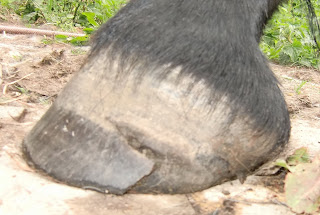Previous post mentioned just how much Thrush there is around at the moment - which seems to be a common theme.
I've found that treating symptoms rather than cause is exhausting, frustrating, sometimes expensive and can have nasty, unintended side effects.
Hard working, naturally kept hooves generally have far less of a problem with Thrush which needs damp, anerobic environment to thrive.
A well kept hoof doesn't provide a happy home for Thrush. The solar surface of the hoof is relatively smooth, forming a natural bowl, making it harder for yuck to make a permanent residence. As the hoof works it flexes (helping to ease out any dirt) and the external structures get scoured by the mixture of soil, grit and the like that the horse travels over.
The frog, conditioned by working hard over a variety of terrain is tough, leathery, has few if any tatters and resists fungal/bacterial attack.
And of course there is no shoe for the Thrush to hide under and no stretched white line for it to nest in.
But if you do get Thrush then be prepared to attack it on two levels. The first being to sort out the management so you grow a healthier hoof and the second is to make the environment less suitable for fungal/bacterial infections.
I counsel against the common practice of using noxious products. If you wouldn't put it on your hair then think twice about putting it on a hoof, after all they are made of the same sort of stuff.
You could do worse than using salt water to scrub the hoof (daily), or use cider vinegar to change the PH (but it stings), again daily. If you have a very stubborn case or no patience and no problem with budget you could try Pete's Goo or maybe a White Lightening or CleanTrax treatment. (Personally I have found daily slooshing with salt water just as effective).









































